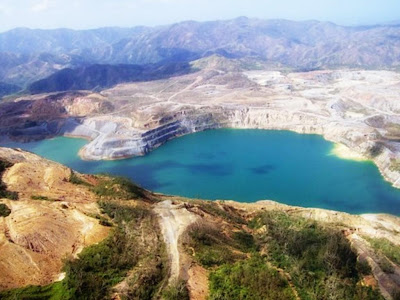 |
| Marcopper mine site, Sta. Cruz, Marinduque |
But what has Barrick Gold got to do with Marinduque, you might ask? Barrick Gold Corporation is the gold mining company that acquired Canada’s Placer Dome in 2006. Placer Dome co-owned and managed Marcopper Mining Corporation. In 1996 millions of tons of mine waste leaked into the 26-km long Boac River, in what came to be known as the “Marcopper Mining Disaster” that brought national and international attention to Marinduque.
Barrick Gold was then included as defendant in a case filed by the Provincial Government of Marinduque in 2005, in Nevada, closer to Barrick’s home. In 2009, an appeal judge overturned Barrick’s attempt to have the case moved to a U.S. federal court and ordered the case to be heard in a district court in Nevada.
Also in 2009, Catherine Coumans of MiningWatch Canada, a mining watchdog group, testified before the committee on foreign affairs and international development in the House of Commons regarding a bill. The bill would impose sanctions on Canadian resource companies that violate good governance and environmental standards.
Coumans focused much of her presentation on the Marinduque case. “All the cases we are currently working on now have the same elements (as Marinduque) – environmental devastation, human rights abuses, lack of recourse, weak governance and corruption,” Coumans said. Read
 |
| Marcopper's Tapian Pit |
Reno, Nevada (AP) – The U.S. Environmental Protection Agency has ordered three northern Nevada gold mines to pay a total of $618,000 for failing to report the release of toxic chemicals, including cyanide, lead and mercury from 2005-08.
All three mines are subsidiaries of the Toronto-based Barrick Gold Corp. – Barrick Cortez Inc.’s Cortez Gold Mine near Crescent Valley, Barrick Gold US Inc.’s Ruby Hill Gold Mine near Eureka and Homestake Mining Co.’s Bald Mountain Gold Mine near the Ruby Lake National Wildlife Refuge.
The three agreed to pay a total of $278,000 in fines and spend an additional $340,000 on an environmentally beneficial project as part of a settlement for allegedly underestimating reports of their toxic release inventory required under the federal Emergency Planning and Community Right-to-Know Act, EPA officials said.
“Cyanide, lead and mercury used at these mines have the potential to pose a health threat,” said Jared Blumenfeld, EPA’s regional administrator for the Pacific Southwest Region based in San Francisco.
“We insist on accurate reporting of chemical releases so that citizens have a clear idea of the risk from the facilities near their communities,” he said. He added there is no evidence to suggest that the violations posed any immediate danger to workers at the facilities or neighboring communities…
Barrick officials said EPA disputed fewer than 40 of the 330 related reports the companies filed during the time period. “Barrick diasagrees with EPA’s position and the company’s operations have complied in good faith with all requirements of annual TRI reporting since 1998,” said Louis Schack, director of communications for barrack Gold of North American based in Salt lake City, Utah.
“Nonetheless, to achieve regulatory certainty regarding its TRI obligations, Barrick has agreed to enter into a settlement agreement with EPA,” he said Wednesday.










No comments:
Post a Comment